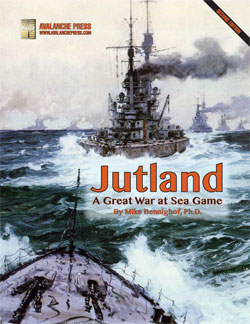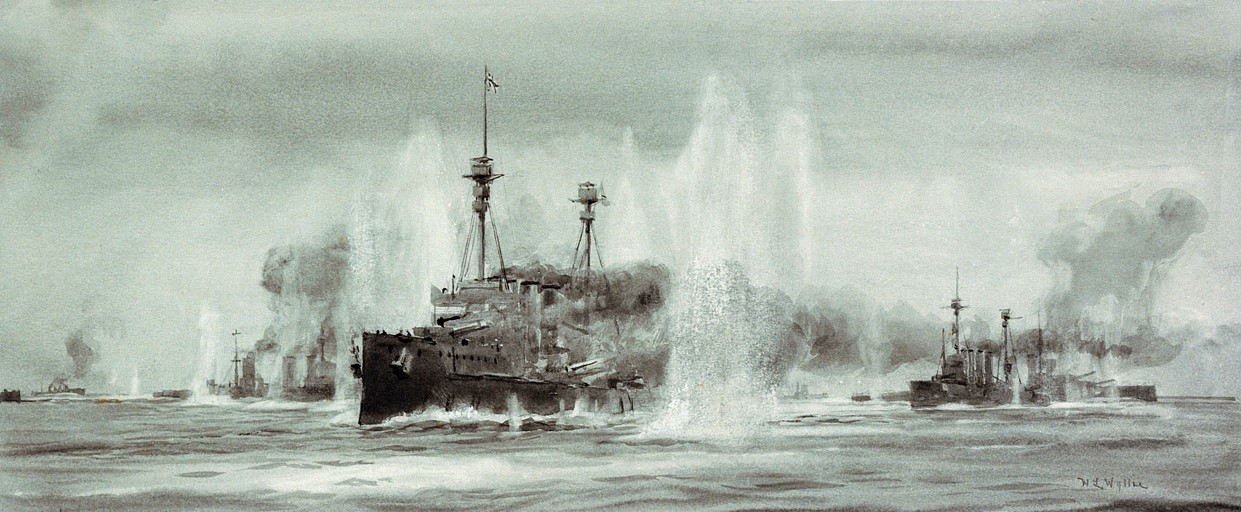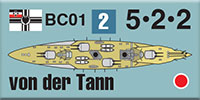| Jutland:
The Battle, Part Four:
Run to the North
By Mike Bennighof, Ph.D.
June 2024
 As the British battle cruisers turned away from the oncoming High Seas Fleet, they steadily pulled out of range of the German battleships’ guns. Sir David Beatty, commanding the British battle cruisers, apparently wished the fast battleships of Fifth Battle Squadron to follow him. Not for the first time during this battle, his flag lieutenant fumbled the signals, this time leaving the last turn signal flying, causing Rear Admiral Hugh Evan-Thomas – who was unaware that the German battle fleet had been sighted - to remain on his southward course for several minutes, fighting the entire High Seas Fleet with his four super-dreadnoughts. As the British battle cruisers turned away from the oncoming High Seas Fleet, they steadily pulled out of range of the German battleships’ guns. Sir David Beatty, commanding the British battle cruisers, apparently wished the fast battleships of Fifth Battle Squadron to follow him. Not for the first time during this battle, his flag lieutenant fumbled the signals, this time leaving the last turn signal flying, causing Rear Admiral Hugh Evan-Thomas – who was unaware that the German battle fleet had been sighted - to remain on his southward course for several minutes, fighting the entire High Seas Fleet with his four super-dreadnoughts.
Six German torpedo boats fought their way through the screen of British light cruisers and destroyers to press their attack while the battle cruisers and battleships passed one another, greatly increasing the odds of obtaining a hit. Despite the double row of targets and optimal range and firing angle, all seven torpedoes launched missed both sets of British ships.
The big British ships dished out considerable pain during this phase, scoring thirteen 15-inch hits on German battle cruisers and five more on German battleships. Meanwhile they absorbed a great deal of punishment, with three of the ships suffering thirteen heavy-caliber hits between them. Malaya lost 65 men killed, while Valiant was not hit at all.
Six 15-inch shells hit the German battlecruiser Seydlitz, putting another gun out of action and starting a cordite fire in an already-disabled turret. Von der Tann’s last operable gun turret jammed, but her captain Hans Zenker (future commander-in-chief of the post-war Reichsmarine) maintained her position in line so that the British could not concentrate their fire on the other battle cruisers. Scheer signaled Ran an der Feind – “Have at the enemy” – urging the battle cruisers to press their pursuit of Beatty.

The last minutes of HMS Defence.
At 1830, a 12-inch semi-armor-piercing shell from one of the German battleships – it’s not clear which – struck Malaya’s starboard six-inch battery, igniting a fire in the ready ammunition that flashed into the shell room below. The magazine crew instantly shut the fireproof doors leading to the shell room, averting an explosion that would have ignited the neighboring 15-inch magazine as well and broken the ship in half.
At 1840 the German battle cruisers had come into range of their British counterparts again and Beatty ordered his ships to open fire. Only two of the German dreadnoughts had the speed to remain within range, and Scheer ordered his battle fleet to reduce speed to 15 knots and resume their formation. So far, the British had mostly kept the range at their preferred distance, where their larger 15-inch and 13.5-inch guns could reach the Germans, but the German 280mm (11-inch) and 305mm (12-inch) guns could not reach them. The Germans instead took out their frustration on the British light ships brawling with their German counterparts between the opposing heavy ships.
Unknown to Hipper and Scheer, Jellicoe’s Grand Fleet bore down on them from the north-west. Rear Admiral Sir Horace Hood of the 3rd Battle Cruiser Squadron raced ahead without orders, as did Sir Robert Arbuthnot with his 1st Cruiser Squadron, also acting on his own initiative. Hood had three older battle cruisers, with only a vague idea where the enemy might be found – Beatty ignored his repeated requests for information, forcing Hood and his staff to make their best guess. They overshot their interception and now appeared on the eastern, unengaged flank of the Germans. Arbuthnot’s four obsolete armored cruisers had no business engaging the heart of the German battle line, but came within range as they attacked the German light cruisers screening Hipper’s battle cruisers.
Hood’s battle cruisers likewise opened fire on the German light cruisers, disabling Wiesbaden. Throughout the engagement the 3rd Battle Cruiser Squadron shot better than any other British squadron; their deployment to Scapa Flow for gunnery exercises paid off handsomely. German torpedo boats in turn attacked them, failing to register any hits but causing them to temporarily veer away from the battle. Wiesbaden also drew the attention of the British light ships; Lt. Commander (and future Home Fleet commander) Jack Tovey of the destroyer Onslow torpedoed her. And then Arbuthnot’s armored cruisers opened fire, but still the stubborn cruiser refused to sink.
Hood’s heedless charge had disrupted the Germans, forcing Hipper to deploy his torpedo boats to ward off the new arrivals rather than attacking Beatty’s damaged ships. That would have allowed the German battle cruisers and leading battleships to reach the Grand Fleet before it had deployed for battle, disrupting Jellicoe’s attempt to form a line of battle and “cross the T” in front of the Germans.
Instead, Jellicoe now had this opportunity, but lacked good information on the location, course, and speed of the High Seas Fleet. His lookouts could pick up the flash of heavy guns, and the rumble of gunfire could be heard on his flagship Iron Duke. Jellicoe asked Beatty where the enemy battle fleet was located; Beatty – whose Battle Cruiser Force’s sole purpose was to provide such actionable data to the Grand Fleet – only replied with the vague suggestion that the German battle cruisers approached from the south-east.
 The Grand Fleet had steamed to the battle area in six columns, which now had to deploy into a single line of battle to meet the Germans. Jellicoe could form up to the west, behind the battleship Marlborough leading the rightmost column, which would have meant deploying while within range of the Germans. Or he could turn east, behind King George V at the head of the leftmost column, taking him away from the Germans but placing him across the path of the oncoming High Seas Fleet if he and his staff had guessed correctly. The Grand Fleet had steamed to the battle area in six columns, which now had to deploy into a single line of battle to meet the Germans. Jellicoe could form up to the west, behind the battleship Marlborough leading the rightmost column, which would have meant deploying while within range of the Germans. Or he could turn east, behind King George V at the head of the leftmost column, taking him away from the Germans but placing him across the path of the oncoming High Seas Fleet if he and his staff had guessed correctly.
Jellicoe took the fateful decision to follow King George V, giving the signal “Charlie London” at 1915. One by one, the battleships in each column turned to port, forming a six-mile-long battle line of 24 dreadnoughts in line ahead, with flagship Iron Duke ninth in line and the former Turkish dreadnought Agincourt bringing up the rear. They snaked to the east, putting themselves across the bows of the approaching High Seas Fleet.
Standing orders called for Evan-Thomas’s Fifth Battle Squadron to lead the Grand Fleet, but his supposedly “fast” battleships lacked the speed to quickly catch up with King George V. On his own initiative – once again, not the done thing in the Royal Navy of 1916 – he steered for a position in Agincourt’s wake. As the squadron did so, Warspite’s helm refused to answer thanks to battle damage, and the super-dreadnought could only turn in circles. At least a dozen Germans ships fired at her, scoring at least 20 hits during this phase of the battle.
Meanwhile, Arbuthnot drove his squadron of armored cruisers after the hapless Wiesbaden, paying no attention to the approaching German battle cruisers and High Seas Fleet. That quickly brought disaster; at 1920, his flagship Defence disappeared from view under a hail of heavy shells. Her explosion could be heard throughout both fleets; all 903 men aboard, including the admiral, died with their ship. Warrior, immediately astern, caught fire from a hit forward and only survived thanks to the smokescreen provided by her own burning hull and the explosion of Defence.
At 1930, the smoke suddenly cleared to reveal Hood’s flagship Invincible to the German battle cruisers Lützow and Derfflinger. The two Iron Dogs poured three rapid salvoes at the British ship, and one shell – apparently from Lützow – blew the roof off one of the amidships turrets and the flash from that explosion detonated both amidships magazines. The ship broke in half, with all but six of her crew killed in the explosion.

Battle cruiser HMS Invincible explodes.
While Jellicoe’s scouting forces failed him, so did Scheer’s. The German surface scouting forces commanded by Hipper had not, as yet, sighted the body of the Grand Fleet and only knew that they had encountered still more battle cruisers and armored cruisers. But overhead, the zeppelins L14, L21 and L23 contributed no useful data (nor, to be fair, did Scheer think to ask for any).
Instead, Scheer would find the Grand Fleet across his path. The first British dreadnought, Marlborough, opened fire at 1917, and by 1934 the horizon was aflame with British gunfire. The battle had entered a new phase.
The story continues in Part Five.
Order Jutland second edition here.
The Jutland Experience
 Jutland Second Edition (full game) Jutland Second Edition (full game)
Jutland: North Sea 1914
Jutland: Dogger Bank
Journal No. 46: Iron Dogs
Retail Price: $179.96
Package Price: $150.00
Gold Club Price: $120.00
You can order the Jutland Experience right here.
Sign up for our newsletter right here. Your info will never be sold or transferred; we'll just use it to update you on new games and new offers.
Mike Bennighof is president of Avalanche Press and holds a doctorate in history from Emory University. A Fulbright Scholar and NASA Journalist in Space finalist, he has published a great many books, games and articles on historical subjects; people are saying that some of them are actually good.
He lives in Birmingham, Alabama with his wife, three children, and his new puppy. His Iron Dog, Leopold, could swim very well.
Want to keep Daily Content free of third-party ads? You can send us some love (and cash) through this link right here.
|
